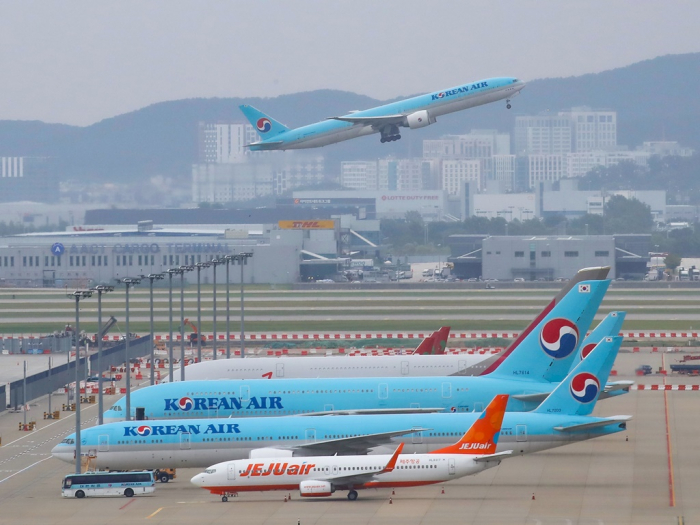
Incheon International Airport, South Korea Global airlines are increasing flights to a pre-pandemic level as countries worldwide are opening up their borders to support the tourism sector, ramping up demand for international trips.Asiana Airlines Inc. decided to resume a flight to Nagoya, Japan, leading the South Korean industry’s move to take advantage of an expected recovery in such demand.Global airline capacity was set to total 417.6 million seats in April, surpassing 401 million seats recorded in February 2020 before the COVID-19 hit the globe, according to aviation data firm OAG. The global airline capacity refers to the number of passenger seats supplied by airlines worldwide, and it is often used as a leading indicator to gauge demand.In early 2020, the capacity tumbled as airlines around the world suspended passenger flights in the aftermath of the pandemic. The number of seats they supplied nosedived 67.7% to 153.7 million in April 2020 from 476.6 million in January of the year.But the industry geared up to take off again as the Omicron variant, which is more contagious but less severe, allowed governments worldwide to ease restrictions against the COVID-19.The International Air Transport Association (IATA) expected air travel demand to explode from the second quarter, just ahead of the summer vacation period, as nations abolished regulations on entries.South Korea said last week that fully vaccinated South Koreans and foreign visitors from overseas do not need to self-quarantine from March 21, except for those from Pakistan, Uzbekistan, Ukraine and Myanmar. Currently, all people who enter South Korea must self-quarantine for seven days regardless of their vaccination status.V-SHAPED RECOVERY IN TOURISM DEMANDSouth Korea’s aviation industry expected demand for international flights to surge as global authorities eased rules on entries. Travel agencies aggressively launched international tour packages for the coming summer peak.“Given the reservation for the Saipan route designated as a travel bubble at almost full, demand that has been suppressed by COVID-19 will explode in a V-shape,” said an industry forecast.Australia, dubbed “fortress Australia” for its strict border controls, reopened its borders to all vaccinated tourists last month, while the Philippines followed the suit from March 10. Thailand, South Koreas’ favorite travel spot, requires tourists a quarantine of only one day. Vietnam is considering reducing a quarantine period to one day from three days.The South Korean airline industry predicted a gradual recovery in international flight demand, starting from regional flights such as routes for Japan and Southeast Asia.“Demand is expected to keep increasing unless we get other variants of COVID-19, although it will take one or two years for the demand to fully recover to the pre-pandemic level,” said an industry source.CONVERSION OF FREIGHTERS TO AIRLINERSSouth Korea’s airlines are rushing to prepare for long-distance flights as self-quarantine regulations were eased, while their foreign competitors were set to launch new routes between the country and Europe. Asiana's aircraft at Incheon International Airport Asiana, the nation’s No. 2 carrier, announced on Monday that it will resume a flight between Incheon, in which South Korea’s top airport is located, and Nagoya once a week starting from April 1. The route has been suspended on April 29, 2021.“We decided to restart the flight in line with Japan’s move to ease the restriction on the number of visitors and quarantine measures,” a company official said.Asiana is set to increases major routes to the neighboring country. It will raise flights between Incheon and Narita International Airport in Tokyo to every day from six times a week, routes to Osaka to five a week from three, and flights for Fukuoka to two from one, starting from March 27.The airline also plans to operate flights between Incheon and Hawaii three times a week, which has been suspended in March 2020.Its larger rival Korean Air speeded up measures to restart international flights.“We are preparing to deploy aircraft at any time, closely monitoring future demand for routes,” said a company source.Korean Air is operating 39 flights out of its 110 routes, while Asiana is running 25 out of 71, according to industry sources.Both plans to convert freighters back to airliners once a recovery in passenger flight demand gathers momentum. Korean Air is using 16 aircraft for cargo-only passenger flights and Asiana is operating seven airplanes for such flights. They reported strong profits last year although the COVID-19 crippled international travel by transforming passenger aircraft to freighters to take advantage of the shortage of shipping containers and soaring freight rates. It takes less than a week to convert them to airliners, said sources of the airlines, which has been training pilots and carrying out maintenance works for aircraft.The country’s budget airlines took similar steps. Jeju Air Co. resumed flights between Incheon and Saipan that does not require quarantine thanks to a travel bubble. Air Premia Inc., which started flights between Incheon and Singapore earlier this year, plans routes for the Americas.Foreign airlines are expected to increase flights. Finland’s national carrier Finnair is set to launch a route between Helsinki and Busan, South Korea’s second-largest city. Helsinki is a convenient transit center in Europe for Asians.By Kyung-Min Kang, Jeong Min Nam and Byung-Il Choikkm1026@hankyung.comJongwoo Cheon edited this article.
Most Read